| |
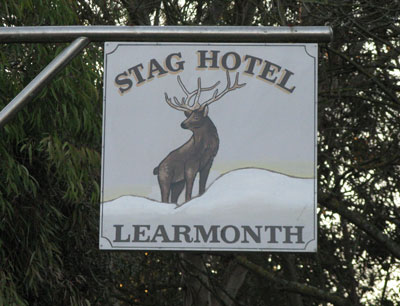 |
1: THE STAG HOTEL
|
|
The two stories below give differing dates as to the establisment of this hotel, further research is being undertaken to try to establish which is correct.
The History of the Stag Hotel.
By Mrs. Murtaugh, reproduced from
"Back To Learmonth" Centenary Celebration 1937.
The Stag Hotel has been closely associated with the early history of Learmonth. It is the second oldest hotel in the Ballarat district, the oldest being Craig's Hotel (originally known as Bath's Hotel). The Stag Hotel was established in 1854, the first licence being granted to a Mr. Mackenzie, and the licence was held by a member of the Mackenzie family continuously for 68 years; surely a record for any hotel in Victoria.
|
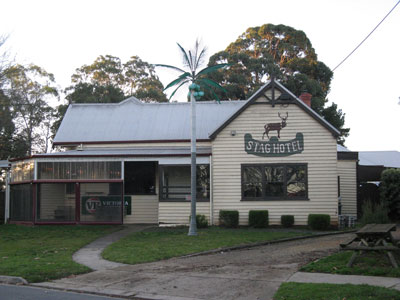
|
|
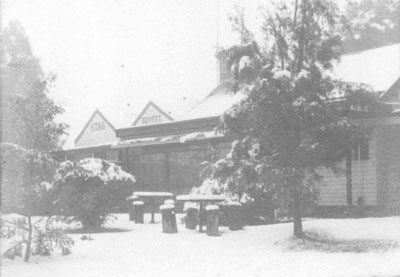
Stag Hotel covered in snow.
|
There are on record meetings of the Cemetery Trust, Roads Boards and other pioneer bodies being held at the Stag Hotel as far back as 1858. To-day it is the only survivor of the many hotels opened in the Learmonth district. Situated at the junction of the Weatherboard and Avoca Roads, it has always been the centre and calling place for all traffic to Ballarat, and the older generation, and perhaps some of the Come-back, will remember the gold mining boom days, with twelve coaches leaving the Stag Hotel daily, carrying the miners from Avoca, Talbot and Fiery Creek rushes to Ballarat.
What a busy place it must have been in those days, with its large stables and dozens of horses. What is to-day the billiard room was in those days the bar and booking office for all the coaches. in the early days most of the land surrounding the hotel belonged to Mr. Mackenzie, and what is now Alexander park and the recreation ground belonged to the hotel. Race and sports meetings were held there regularly, horses coming all the way from Melbourne to compete.
There was also a bicycle track, and bike races were held at a later date. The last of the Mackenzies to hold the licence of the Stag Hotel sold the sports ground to the Shire Council, so that the people of Learmonth should have a sports ground for all time.
|
|
Back in the seventies and eighties, when ploughing matches were booming, the Stag Hotel was the meeting place for champion ploughmen, and many matches were arranged here. Some of the older folk will remember the interest taken, when men came from as far afield as New South wales to compete in the champion ploughing matches.The early licencees seem to have taken a great interest in sport of all kinds, and participated in the boat races and regattas on Lake Learmonth. One of the boats last used on the lake was owned by one of the members of the family.
For very many years the Ballarat Shire Council held its annual President's Dinner at the Stag Hotel, and numerous Presidents, long since departed, presided over large gatherings on those occasions, when members of parliament and visitors came from far and near; and the Stag has had many notable men under its roof.
Many changes have been made since the first licence was granted, and the big stables are not used so much now that the motor car has supplanted the horse. Still the hotel serves a large district.
The proprietor, Mr. H. T. Murtaugh, extends a cordial invitation to any of the Home-comers to come and have a look through this old landmark of early Leamonth.
A hearty welcome awaits you.
|
|
The following article was researched and written by LDHS member,
Mrs Claudette Crick.
The McKay family, who left Scotland at the time of the clearances in Sutherland County, arrived in Melbourne in 1854 on board the vessel, Hilton. William McKay came to Learmonth the mid 1850s, pitching his tent on the ground on which the Lady of the Lake Hotel was later built. He commenced trading as a storekeeper realizing the amount of traffic through the area, to the goldfields, could support a viable business.
In August 1857 William McKay, who was planning to commence the construction of his hotel on his corner block, received a letter from the Committee of the Learmonth Presbyterian Church intimating "they didn't want a public house on their proposed site". A short time after this the church committee found what they considered to be the best site and purchased the necessary goods from Mr McKay to build their church that opened in Feb. 1858. Perhaps in appreciation for not building on his chosen land, Mr McKay presented an 8-day clock to the committee to place in the new church.
|
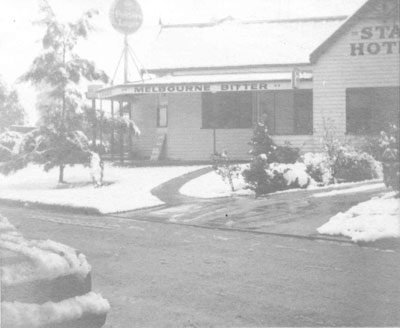 |
|
William McKay had applied for a hotel licence from the Ballarat Court of Petty Sessions before 1859, so the Stag Hotel situated at the junction of Weatherboard and Avoca roads was well in business before he purchased the land at auction in 1859. Cobb & Co had opened up a new era by transporting passengers to the goldfields. They made arrangements with hotelkeepers for passenger meals, accommodation, stabling horses and changing teams. The Stag Hotel which was also a Cobb & Co changing station catering for passengers on up to 6 coaches a day, had a total of 7 bedrooms, 4 of which were for public use and a dining room which seated 16 people. William was the licensee until 1863 followed by his brother-in–law, Murdoch McKenzie. William continued ownership of the hotel until his death in 1870 and it remained in his estate until 1894.
In the following stories, much will be told about William McKay known as the Father of Learmonth.
In 1863, the 1st regatta held on Lake Learmonth attracted between 4000 and 5000 people. Murdoch McKenzie, the new licensee of the Stag Hotel was a very keen boat owner. He erected a commodious boathouse, 20 feet by 30 feet, for the accommodation of racing boats expected from Melbourne and other places.
Many different organizations such as the Cemetery Trust, Sailing and Ploughing Committees and political gatherings met at the hotel and the Shire of Ballarat had its lunches in the dining room for many years.
Murdoch McKenzie was the licensee until 1892 when it was transferred to a John McKenzie, from another district family. John became the hotel owner in 1894 when the executors of William's estate, Murdoch McKenzie and Thomas Bath, sold some of the blocks that William had purchased in 1859 and 1860.
|
|
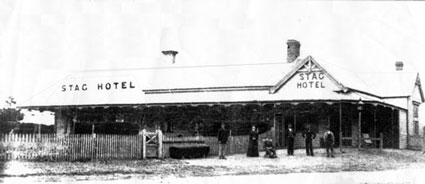
Stag Hotel - 1913
|
The hotel was ideally located, being so close to Lake Learmonth for the use of sportsmen and sportswomen. An advertisement in the Stock and Land Journal of 1913 stated – "For over 50 years, the Stag hotel one of the best-known landmarks in the state has been noted for its genuine excellence. Its position is unique, facing the famous lake which gives remarkable hauls of both Perch and Trout. Several commodious bathing boxes for Ladies and Gentlemen and for Children. The cuisine of the hotel is excellent. First class fishing and shooting".
During John McKenzie's ownership, an Ada McKenzie who was probably his daughter, was the licensee, on and off until 1916. She became the owner of the hotel from about 1910 until Herbert T Murtagh purchased it; date possibly 1942, although he was connected with it when Learmonth held a "Back To" in 1937. During the time of Ada McKenzie's ownership, licensee names regularly changed. Since 1943 licensees have included – G T Kelly, F J Keogh, R G & P J Simpson, P J Browne & N J & J F Plozza.
Between 1943 – 1988 owners have included – Gerald T Kelly, Francis J Keogh, Henry J Young, R J & H M Howard and D A T & D A Muir, K & T J Hall, A A E & B Carter.
With the demise of the goldfields, the introduction of the motorcar, the removal of passenger trains through Learmonth, the Shire Council shifting its offices to Ballarat and the lake now being dry for many years, the Stag hotel is very different from in its hey day.
|
| |
Return to sites list
|
|
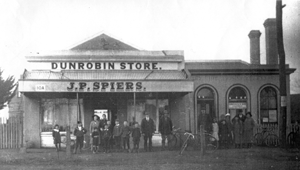
Early 1900s
|
|
|
|
William McKay purchased Section E Allotments 1 & 2 at the Learmonth land sales in 1859 & 1860.
He had already built the Stag Hotel on Allotment 1 and after purchasing the land, built cottages and shops, with dwellings attached. One of the cottages was used as the first police station and from the rate notices of 1863, we see the shops were rented for other businesses.
With more people moving into the town following the land sales, a Post Office opened as Lake Learmonth in 1858 with William McKay as Post Master. He would have run the PO with a small trading business from the hotel.
By 1861 it was reported in the Ballarat Star that William McKay was erecting a very handsome structure of brick and bluestone, for the purpose of a Store and Post Office. The store known as Dunrobin Store still carries the name from Dunrobin Castle in Golspie, County Sutherland Scotland, near to the original McKay family home. Around the same time he built his family a villa residence described as one of the finest in the township.
|
June 2008
|
|
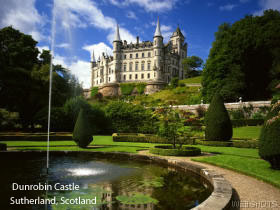
Dunrobin Castle, Sutherland Scotland
after which the Dunrobin Store was named
|
Until his death in 1870 William not only held the position of Post Master but, like many other district men, was also contracting for the District Road Board, later the Shire of Ballarat, in building roads, bridges etc. as the town and district developed.
It is believed William would have had a manager to run the store while he was contracting and Mrs McKay raising the family.
An advertisement of 1869, when Arthur Staunton was probably managing for the McKay's showed how useful the business would have been for the local population –
Goods for Sale: A choice of drapery, crockery, groceries, ironmongery, chaff cut, grain etc. Registrar of Births, Deaths and Vaccinations and Agent for the Ballarat Mutual Employment Institute. Arthur Staunton – Dunrobin Store - Learmonth.
From 1870, William's wife Margaret, daughters Grace and Isabella each held the position of Post Mistress. In 1891, the Post Office and Store were sold to the Spiers family who had run the store for some years prior .
In about 1917 the business was purchased by Mr Crosthwaite. |
|
|
Researched and written by LDHS Member,
Mrs Claudette Crick.
|
Return to sites list
|
(with them both)
|
3: Stafford General Store.
The site of the former Stafford General Store.
General store, tobacconist and stationer.
The store burnt down in1912.
It would appear the Mr Stafford enjoyed the Learmonth streetscape as he commisioned a series of photographs taken from various points.
|
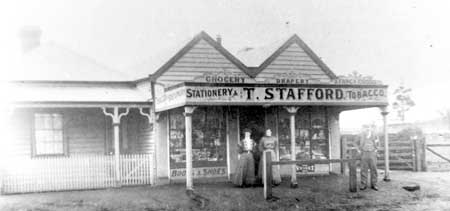 |
| |
Return to sites list
|
|
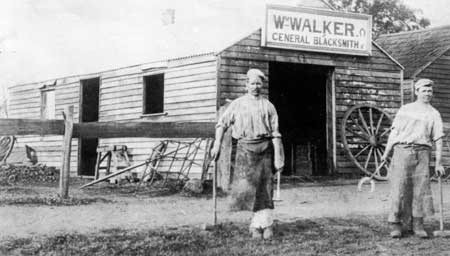
|
4: McGlashin & Cumming
Engineers &Millwrights.
|
|
Originally the site of McGlashin & Cumming Engineers & Millwrights:
Gilbert McGlashan began his engineering business in Learmonth in 1861 in a building owned by William McKay.
In 1863 he took Cummin, a Millwright into partnership, in 1864 they invented a reaping machine for cutting grain crops. Up until then all grain crops were cut by hand using a sickle of scythe. The new reaping machine was pulled by one horse and had a cut of 3 feet. The next model had a cut of 3' 6" and was pulled by two horses. The machine was were much sought after by the district's farmers and in 1865 they had 45 made ready for the forthcoming harvest season.
Ballarat Agricultural and Pastoral Society encouraged competitions for inventors of new farm machinery. The McGlashan Reaper entered in the 1866 annual exhibition was described as "a fine article".
In June 1868 McGlashin applied to the Council for permission to erect two verandas on his business premises.
The business was sold in 1884 to William Wilson Walker who continued the blacksmithing business. He was able to purchase the land in 1891 from the trustees of William McKay's estate. William's brother-in-law, Alf Sandford, 10 years William's junior was apprenticed in the business for sometime.
One day William was invalided by a kicking horse as he shod it, his injury failed to heal later resulting in the amputation of a leg. William's two sons Charlie and Keith managed the blacksmithing and gradually took over the business. As his artificial leg limited his mobility William now concentrated on a boot and shoe repair business.
William and his wife Annie also owned enough land for several house blocks.
William Walker was well known for playing his violin at many district functions.
The family business changed to a garage as motorcars were introduced.
In 1910, Learmonth residents owned 2 cars and 7 motorcycles.
|
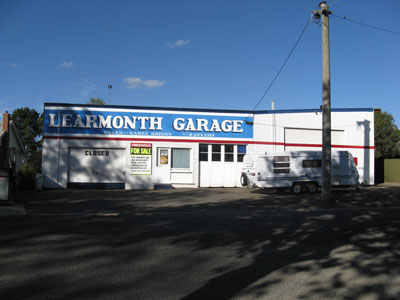
Learmonth Garage (November 2008).
The current building on the site.
Neville Goldsmith bought the business from the Walker Brothers in 1969 and changed the facade to that of a modern garage. The business was later sold to Brian Briody who closed it in 2006/7.
|
| |
Return to sites list
|
| |
5: Dr. Creelman's Surgery & Chemist.
|
|
Site of the former Dr. Creelman's Surgery & Chemist Shop.
Dr. John Creelman was one of the first doctors in Learmonth, attending to the medical needs of the township as well as being the coroner for inquests. He purchased Allotment 3 Section E, at the 1860 land sales, on which he built his home and surgery, later building a chemist shop in the front.
Although the home has been considerably altered and extended, the original stone wall of the surgery is still visible. When members of the Learmonth and District Historical Society dug the hole for the ‘Heritage Walk’ post a number of old medicine bottles were unearthed.
The following advertisement was placed in ‘The Argus’ of 4 March 1874 regarding Dr Creelman’s medical practice:
To Let, suitable premises for a medical practice, situated in High St. Learmonth, including a dwelling containing 5 rooms, surgery, kitchen, servants room, stable and coach house. Also 2 acres of land, comprising a well stocked garden of fruit trees and valuable plants. The above offers a good opening for members of the profession, seeing that there is a large area of country and a population that will secure a remunerative practice. Apply Post Office, Learmonth.
|
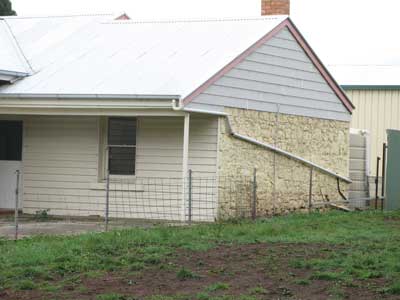 |
| |
Return to sites list
|
| |
6: Lady of the Lake Hotel
|
|
Site of the former Lady of the Lake Hotel.
More details coming soon.
|
|
| |
Return to sites list
|
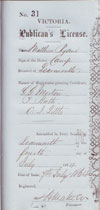 |
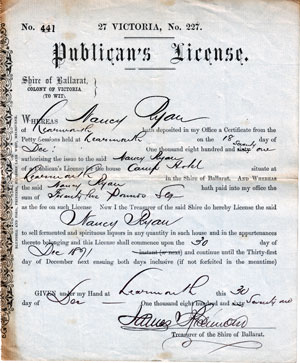 |
7: Camp Hotel
|
|
Mr Hedrick was an early settler in Learmonth, purchasing a block of land at the 1859 town lots sale. In 1860 he was a storekeeper selling groceries, paints, ironmongery and merchandise, and by the end of 1861 he had completed a new store to be used as a grain and produce store.
He next applied to build extensive additions to his dwelling house, and apparently noticing the town of Learmonth was rapidly developing he also applied for a hotel license.
This was the beginning of the Camp Hotel and in 1863 Matthew Ryan who had previously been licensee of the Golden Well Hotel at Dowling Forest, became the first licensee. In the same year Mr Hedrick died and Matthew Ryan purchased the hotel and continued the business. The Ryan family decided not to continue with the store and by May 1864, James Oddie & Co held a "Sale By Auction" of goods at the store of the Late Mr Hedrick.
It is interesting to note the variety of goods that Learmonth residents were able to purchase.
*********************************************************
Groceries, Oilman’s Stores, etc (in small quantities for private families), comprising coffee, black and orange pekoe tea, biscuits, chocolate and cocoa, jams, salad oils, pickles, sauces, sugar, cheese, oatmeal, currants, candles, starch, lemon and orange peel, raisins, spices, lollies, etc etc.
GROCER’S UTENSILS
Such as platform scales and weights, canisters, scoops, measures, ornamental bottles and show tins etc. SADDLERY AND IRONMONGERY also, an excellent assortment of HOUSEHOLD FURNITURE, comprising rocking and other chairs, folding sofa, tables, large pier glass, chiffonier, pictures, books, cutlery, delph, culinary utensils, etc.
*********************************************************
A fire occurred at the Camp Hotel on 6th Sep 1900. Fortunately only the stable was destroyed.
Members of the Ryan family held the licensee until1907. A James Ackers or Aikers was licensee from 1907 – 1910, followed by John Doolan until 1913.
In March that year the license was transferred to George Ashmore. Later, in July a J P Wilson claimed ₤48/10/- from John Doolan as commission for introducing George Ashmore as a prospective purchaser for the hotel. A private sale had followed which had incensed Mr Wilson. A court hearing was held, but owing to Ashmore being unable to attend owing to illness, the case was adjourned.
*********************************************************
Some tough characters visited the Learmonth hotels. Following is a report from the 8th July Argus, 1908.
A FORMIDABLE PAIR
George A Garvie and his brother Robert, two men residing in Learmonth, on Tuesday paid the penalty for a fracas in which they joined on the 25th of last month. On the afternoon of that date Constable Hart was informed that the two brothers had created a disturbance at the Balmoral Hotel, about a mile from Learmonth and the people there were afraid for their lives. On arriving at the place he found the two brothers had been fighting, George having repeatedly knocked his brother down. Hart advised them to leave the place, and John Whateley supplemented his advice.
In return Whateley was assaulted by George Garvie who struck him on the mouth, felling him to the floor. Hart next received the attention of the couple. One of them threw him into the corner of the room then lay across his neck nearly choking him, while the other proceeded to knock him about. Hart extricated himself, but the attack was renewed when he experienced another bad time of it, and wisely withdrew for the time being. The Garvies left some time later ands drove to the Camp Hotel Learmonth where Hart made another attempt to apprehend them, but they got away, leaving their vehicle behind them. He reported the matter, and warrants were issued for the arrest of the two men. Constables Hart, Hevey of Miners Rest and Harnetts of Waubra subsequently took them.
Powerfully built fellows with 50-inch chests, they were charged ₤5 each for the first offence and ₤1 each for the second.
*********************************************************
In Oct of the same year, the license was transferred to Ada McKenzie of the Stag Hotel, 1914 to Evelyn Webb and 1915 – 1916 to William Stewart when it was de-licensed and demolished.
The late Arthur Goad remembered attending, with his father, the sale of the Camp Hotel furnishings. They purchased a single bed for Arthur who in later years did not know of its whereabouts. He also suggested that doors from the hotel were probably put into some Learmonth homes.
|
| |
Return to sites list
|
|
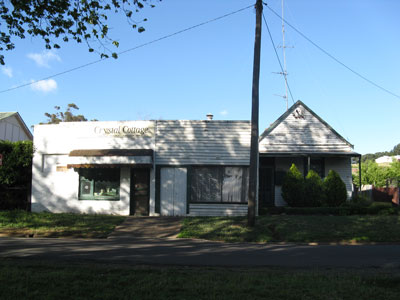
Thos. Lewis' drapers store as it was in November 2008
|
8: Thos. Lewis Draper
|
|
This is one of the oldest buildings in Learmonth.
Thomas Lewis opened a drapery store (tent) in Criterion St. Bald Hiils (the Bald Hills Diggings) in 1861. He moved into Learmonth in 1864 setting uo shop next to the Camp Hotel. In February of 1864 he applied to the Shire of Ballarat for permission to erect a verandah over the footpath in front of his business.
When Lewis died in 1874 William Rain took over the business. Wally Walters had his butchers shop here for a number of years.
|
More detail coming soon |
| |
Return to sites list
|
9: National Bank Building
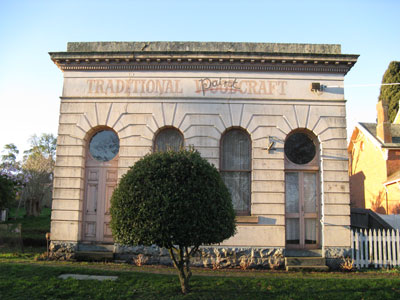
The former National Bank Building - June 2008.
|
Prior to the opening of the Learmonth branch of the "National Bank of Australasia" the local correspondent to the "Ballarat Star" wrote:- The building at Learmonth for the local branch of the National Bank has a substanial and neat appearance. The question has arisen - when is the manager coming out with his money bags and when is the bank to be opened. Many people expressed their intention of opening accounts, enabling the bank to establish a good business.
The Learmonth branch of the "National Bank" opened for business on November 19th 1866 with Mr. E E Crombie as its first Manger.
The Shire of Ballarat shifted its business from the Bank of Victoria to the Learmonth branch in 1868.
The Learmonth NAtional Bank was one of the first two rural National Banks to be established, after the agricultural population became more stable after the mining frenzy.
In 1871, the bank made conciderable additions and improvements to the old wooden building by erecting a substantial front of stone and brick.
Bank Managers were held in high regard in the community, as they joined in community activities and promted the welfare of the district. A presentation evening was usually given to the departing manager, attended by members of the council, influential comminity members and interested members of the public. At these evenings, which were usually held in the Shire Hall, the incoming manager was welcomed.
The Manager's residence was attached to the rear of the bank as shown in the 1907 photo (below left).
Article researched and written by Mrs Claudette Crick.
The current owner has plans to open an antique and coffee shop.
|
|
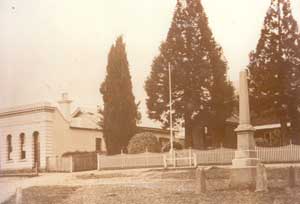
This 1907 photo shows the Bank building and managers residence which has since been demolished.
|
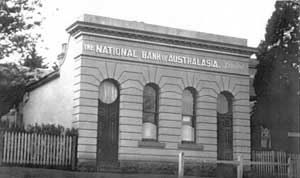
"In 1871, the bank made a considerable addition and improvement to the old wooden building by erecting a substantial front, composed of stone and brick, the design being of a neat appearance".
Quote from "Glimpses of a Past Era". Learmonth & District Historical Society 2005.
|
Bank Managers
|
Second Officers.
|
|
Nov 1866 - May 1869. E E Crombie
May 1869 - Dec 1870. J E Ochiltree
Dec 1870 - Nov 1875. W L A Elston
Feb 1876 - Mar 1878. R H Barry
Mar 1878 - 1880. D Binnie
1880 - May 1882. J W B Gardyne.
May 1882 - Aug 1884. F J Daniel
Aug 1884 - Aug 1888. A Young
Aug 1888 - Aug 1893. W L Thomas
Aug 1893 - May 1895. G E Peart
May 1895 - Jul 1900. W Bruce
Jul 1900 - Jan 1906. J A McGillivary
Jan 1906 - Nov 1912. W L Hunter
Nov 1912 - Apr 1918. F Tolstrup
Apr 1918 - Aug 1921. E B Proudfoot
Nov 1921 - Jan 1924. H Reilly
May 1927 - Apr 1931. H A Carne
Apr 1931 - Jun 1937. J O McAllister
Jun 1937 - Apr 1948. A A James
Apr 1948 - Jan 1950. S C S Field
Nov 1950 - Dec 1955. H G Mitchell
Dec 1955 - H J Scarfe
|
30-3-1921 to 9-10-1922. C R Jenkins
9-10-1922 to 9-1-1925. F J Goding
9-1-1925 to 25-8-1926. J W R Vining
25-8-1926 to 12-4-1928. C L Howell
12-4-1928 to 4-12-1928. W C Brand
4-12-1928 to 18-11-1929. B A Dockery
18-11-1929 to 7-10-1930. S J Davies
7-10-1930 to 15-5-1934. R Murnane
15-5-1934 to 1-5-1936. A E Horsburgh
1-5-1936 to 30-5-1938. C C Bignill
E A Atkins
J J Howdin
H S Weatherall
1942 to 1946. Ann Robertson
D Stockdale
Heathcote
Bowden
K Menhennet
L Lonsdale
G Upton
|
| |
Return to sites list
|
|
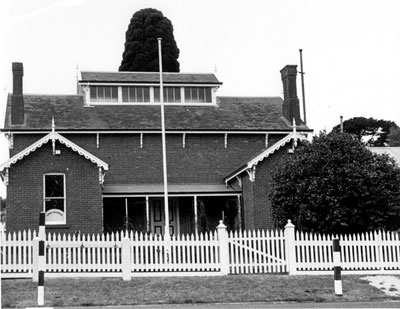
|
10: Shire of Ballarat Hall / Road Board Office:
The Ballarat District Road Board was created on 7th October 1856. The Shire of Ballarat, the first in the state, was proclaimed on 24th November 1863. The foundation stone of the Shire Hall was laid by Cr. Nicholson (Shire President) on 5th November 1866.
The building is now the home of the Learmonth & District Historical Society.
More details coming soon.
|
|
Above: following renovations in 1985.
Right: also showing the Jubilee Gas Lamp - June 2008.
|
|
| |
Return to sites list
|
|
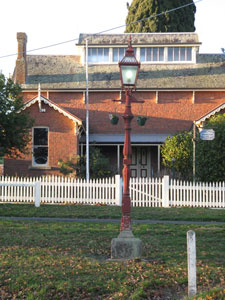
|
11: Gas Street Lamp
Made of cast iron by White's Eagle Foundry , Ballarat, this lamp was erected by the Shire of Ballarat to commemorate Queen Victoria'sDiamond Jubilee in 1897.
|
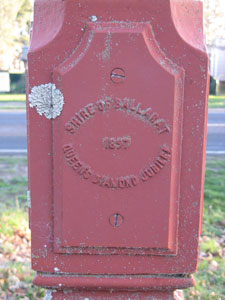
|
The second “Learmonth Thunderer” published in 1897, about 28 years after the first, was printed in commemoration of Queen Victoria’s Jubilee year. Residents of the Shire of Ballarat were treated to many forms of entertainment and the Council decided to place a lamp in the Main Street of Learmonth for the benefit of those folks “when darkness has fallen”.
This article appeared in the “Learmonth Thunderer.”
Lamp to be erected by the Shire of Ballarat.
The light from the lamp to be erected in front of the Shire Hall will no doubt be highly appreciated by residents of the district, and the beneficial effects produced well, we think, show the necessity of erecting a few more lamps in the Township. One is badly needed at the main footpath near the road leading up to Dr Courtney’s surgery; residents from all parts of the district having to drive to the doctor’s at all hours of the night, and this particular corner is a very dark one. Another lamp is required at the Post Office. In connection with the latter, it would be as well to caution mounted men having business at the Post Office on dark nights not to tether their horses across the footpath. The animals may be quiet, but not withstanding this, one is apt to congratulate himself from a narrow escape from a great calamity if he retains sound links after having come in contact with the haunches of a horse. |
1897 TIME CAPSULE
A Masons patented jar, with Shire of Ballarat Token within, was found in the base of cast- iron lamp post in March 1985. At that time, the post was being relocated from the front garden of the former Shire Offices at Learmonth to the medium strip between the Sunraysia Highway and the service road, this being as near as possible to what is believed to be its original position. The jar was in many pieces and had presumably been broken at the time of the post’s shift from the edge of the newly created North Western highway to the garden in 1955.
A replacement lamp was made p by Mr G Edwards of Mount Helen and for the first time since its shift in 1955, it is to be illuminated.
Between 1880 and 1920 three other similar gas lamps were used in the main street of Learmonth. They were all powered with Benzene, the type of light being known as a “Gloria” light.
At that time a kerosene powered light was also in use in front of the Stag hotel and several gas or Gloria lights were in the grounds of the Bowling Greens.
The Masons jar was made by the Consolidated Fruit Jar Company of U.S.A. Mason’s patent, dated November 30, 1858, was for the glass screw thread – the porcelain inserted zinc screw cap was patented by John Landis Boyd of New York.
Due to the jar being broken into so many pieces an “original” replacement jar, identical to the broken one, was acquired from a Bottle Collector for $8.00 in Mar 1985. The token, badly corroded when found, has been cleaned and replaced into this replacement jar.
|
| |
Return to sites list |
|
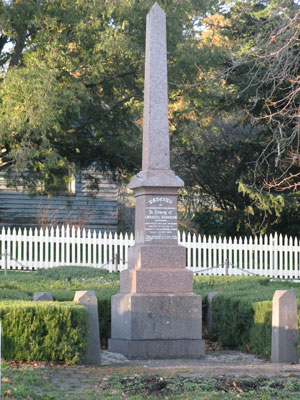
|
12: Boer War Monument
|
|
As the picture to the right shows, the wording on the monument reads;
ERECTED
BY
THE RESIDENTS OF THE DISTRICT
IN MEMORY OF
CHARLES VAUGHAN
SERGEANT
AUSTRALIAN IMPERIAL REGIMENT
KILLED IN ACTION AT
HARTEBEESTFONTEIN, SOUTH AFRICA
FEBRUARY 18TH 1901
|
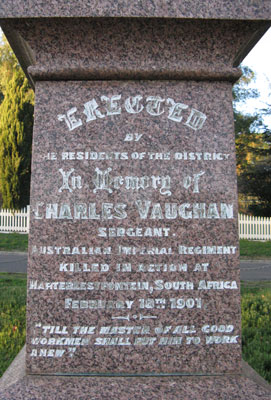
|
|
From the Australian War Memorial Roll of Honour.
Roll of Honour - Charles Vaughan.
Service number: 555
Rank: Sergeant [Sgt]
Unit: Fourth (Imperial) Contingent, Vic
Service: Colonial Military Forces
Conflict: South Africa, 1899-1902
Date of death: 18 February 1901
Place of Death: Hartebeest Fontein
Cause of death: Killed in action
|
Return to sites list
|
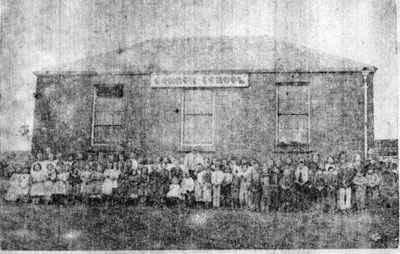 |
13: Learmonth Common School
|
|
386 LEARMONTH:
HT Jonas Horsfall opened SS386 on 8th of February 1859. The School Minute Book gives an account of the School Board Meeting of February 1860. The Board then comprised the Rev. Mr Mackie, the Rev. Mr Lane, Messrs Bath, Hobbs, and McQueen. The HT was George Crockett. In October that year, the Presbyterian Church agreed to take over the management of the school, which moved into the Presbyterian Church. A new school building with brick walls, shingle roof and stone foundations opened in 1862. February 1863 saw Simon Morrison appointed HT, and his wife became SM. School fees, at first 1s 6d per child per week, were later reduced to 1s. In 1869, the school became vested with the Board of Education and the Presbyterian' Church, while in February 1873, the Secretary of the Education Department accepted the offer of the school which then became SS386.
Reproducted from "Vision and Realisation".
|
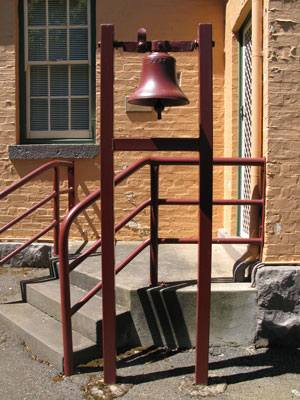
The historical school bell outside the Learmonth Primary School.
|
|
At a meeting of the Learmonth Combined School, run by the Wesleyans and the Presbyterians, on Oct 1860 at the Wesleyan site, it was resolved " that in accordance with the wish of the Wesleyans the school become a Presbyterian School as Mr Pomeroy had resigned." The following gentlemen were elected as the school committee — Messers Laidlaw, Baird, McQueen, McDonald and Findlay.
The school was to be removed to the Presbyterian Church and two weeks later the School Board passed resolutions " to make the Church workable as a school." A building used as a schoolteacher's dwelling house was purchased from Mr Horsfall for £78 ($156).
Mr Crockett who had been the teacher of the Combined School continued as teacher at the Presbyterian Church School.
It was at the meeting of the Learmonth School Board on 27th May 1861, when the historic resolution was passed that a new school room be erected — the said building to consist of brick walls, shingle roof, its dimensions to be 30 feet long by 18 feet wide, with walls 10 feet high above the floor —on stone foundations. In Feb 1862 the Church Committee recommended to the School Board that they erect a school room as soon as convenient After many delays, including the harvest, Mr Barnes built the one room brick school for £172 ($344).
At the Nov 26th meeting parents, and all interested in the welfare of the school, were invited to attend. At this meeting examiners were appointed and also Mr Crockett resigned. It was decided to advertise for a teacher, Mr Morrison being chosen to be Head Teacher and Mrs Morrison was appointed to teach sewing to the girls.
There were many efforts arranged by the district to meet the educational needs of the children and the school was finally free of debt in Aug 1864. A board was procured lettered "Common School" and placed on the building.
On 1St July 1867 the school was referred to for the first time as No 386 and was vested with the Education Department on 24th Feb 1873, becoming known as the Learmonth State School. By this time 100 children were registered at a building that was inspected to have room enough for 67, so it was necessary for the school to be enlarged. School was held at the Temperance Hall so additions could be undertaken.
At the Centenary celebrations of the school on the present site the Head Teacher was Mr Roberts, Assistant Teacher Miss Morgan and Mr F Ryan was President of the School Committee.
|
| Researched at written by Mrs. Claudette Crick. |
Return to sites list |
|
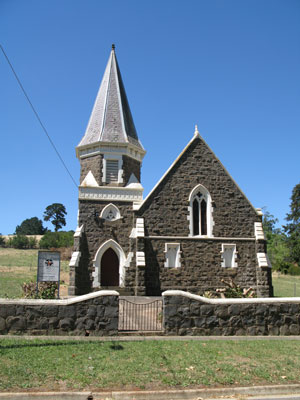
|
History of the PRESBYTERIAN CHURCH, LEARMONTH.
By S. N. Lynch
Reproduced from "Back to Learmonth" Centenary Celebrations 1937.
|
|
On the 13th March, 1857, a meeting was held at the farm of Messrs. Robertson & Ross, Burrumbeet, to take into consideration the erection of a Church, Manse and School at Weatherboard hill, in connection with the Free Church of Scotland. The following were present:- Messrs. Robertson, Ross, Strachan, Hossack, McDonald, Howard, Draffin, Laidlaw, Blair, McDougall and Gilchrist. The following Committee was appointed to carry out the object in view :- Messrs. Robertson, McDonald, Hossack, Draffin, Gilchrist, Laidlaw and Strachan, with the Rev. Mr Hastie as Treasurer, Mr. howard as sub-treasurer, and Mr. A McPherson Grant as Secretary. At a meeting held on the 8th of June 1857, it was resolved to build the Church on the north side of Lake Learmonth,on the 12th June it was resolved to apply to the Government for a building site on the north-west corner of the Reserve situated on the north side of the Lake.
On the 7th July, it was decided that the Mini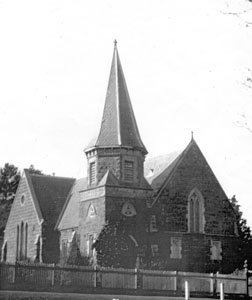 ster should hold Divine Service at the Burrumbeet School House once every Sabbath for at leats 12 months after his induction. It was also agreed that the dimensions of the Church should be 50 x 28 feet and 12 feet walls. On 12th October, 1857, a meeting was held at the residenceof Mr. McDonald. There were Present:- Rev. Geo. Mackie (chair), Messrs. Howard, Stachan, Robertson, McDonald, Hossack, Gilchrist, Draffin and Laidlaw. It was resolved to buildupon a portion of a 45-acre block on the east side of the Lake. It was also resolved to apply to the Presbytery of Geelong for Ministerial supply of Gospel Ordinances. ster should hold Divine Service at the Burrumbeet School House once every Sabbath for at leats 12 months after his induction. It was also agreed that the dimensions of the Church should be 50 x 28 feet and 12 feet walls. On 12th October, 1857, a meeting was held at the residenceof Mr. McDonald. There were Present:- Rev. Geo. Mackie (chair), Messrs. Howard, Stachan, Robertson, McDonald, Hossack, Gilchrist, Draffin and Laidlaw. It was resolved to buildupon a portion of a 45-acre block on the east side of the Lake. It was also resolved to apply to the Presbytery of Geelong for Ministerial supply of Gospel Ordinances.
In the meantime the Church and Manse were erected, for we find that on the 1st January, 1858, a meeting was held in the Church, when it was agreed to apply to the Geelong Presbytery for the services of the Rev. Geo. Mackie for three months. Three weeks later, at a meeting of the Committee held at the Manse, Lake Learmonth, it was arranged to hold services alternately at Lake Learmonth, Mt. Blowhard and Burrumbeet, and the Rev. Geo. Mackie was authorised to treat with the Government for the land on which the Church was built.
On March 10th, the Rev.W. Henderson, of Ballarat, presided at a Congregational Meeting held in the Church, when a call was given to the Rev. Geo. Mackie. The stipend was fixed at not less than 350 pounds and not more than 400 pounds. The Mt. Blowhard Committee agreed to pay one-third of the amount.
The first Trustees of the Church property were:- Rev. Geo. Mackie, Merrrs. Angus Gilchrist, Alexander McDonald and James Hossack. On March 23rd 1859, the first Annual Meeting of the Congregation was held, and it was resolved to sever connection with the Mt. Blowhard portion of the charge. Mr R B Williams was elected Secretary of the congregation in the room of Mr. Grant, and Mr. Jas. Baird was elected to the committee.
On the 2nd Sabbath of May, 1859, the first Communion Service was held: Messrs, James Brewster and Robert Dickie officiating as Elders. During the same year the following were elected and ordained and inducted as Elders of the congregation - Messrs. Robert Dickie, James Hossack, John Mackie Snr., Alex McPherson Grant and James Brewster. In October, 1860, the Rev. Geo. Mackie resigned the pastorate of Learmonth and Burrumbeet owing to failing health. In March, 1861, the Burrumbeet portion of the charge formed themselves into a congregation of their own, instead of a joint Committee.On June 20t, 1861, Rev.John Downs was inducted by the Presbytery of Ballarat. About a year afterwards Mr. Downs accepted a call from Clunes. At this time the arrangmements existing between the Learmonth and Burrumbeet congregations terminated, and a new charge was formed consisting of Learmonth and The Springs (now Waubra). Burrumbeet joined with Windermere in forming a separate charge.
In March, 1863, the Rev J B Steel, of Creswick, presided at a Congregational Meeting, when a call was given to the Rev. Robert Hamilton, M.A. The ordination of Mr. Hamilton took place on May 20th, 1863. In march, 1900, Mr. Hamilton resigned the chatge and retired from the active ministry of the Church owing to failing health.During Mr. Hamilton's long ministry of 37 years, two substantial stone churches were built, one at Learmonth costing about 1250 pounds, and one at Waubra costing about 800 pounds. In addition to these, the present Manse was completed in 1890 and cost about 870 pounds.In the same year the sum of £132 was contributed to the Jubilee Fund of the Presbyterian Church of Victoria.
The foundation stone of the present church at Learmonth was laid by the late Sir Samual Wilson, of Ercildoune, on 24th November, 1875, and the church was opened practically free of debt on 19th March, 1876. In the year 1881 the present fence in front of the church was erected by the late Mr. Alexander Wilson, of Mt. Emu, at a cost of 42 pounds,and presented to the congregation.On 27th May, 1877, Messrs. Wm. Brewster and Wm. Rain were elected and ordained to the office of ruling Elders in the congregation. On 28th November, 1900, the Rev. J A Crockett was inducted as Minister. In February, 1904, Mr. Crockett was translated to Brunswick, and Rev. John Smiley, B.A, was inducted in November, 1904. On 13th October, 1907, Mr. John Baird was ordained to the office of ruling Elder in the congregation.
In 1909 a Sunday School, built of stone, was added to the church at a cost of £600. In 1913 the Rev. J Smiley accepted a call to Sandringham, and Rev. J K Robertson was inducted on the 7th MAy, 1914. In 1916 he accepted a call from Murrumbeena, and Rev. J H R Halford was inducted on July 27th, 1916. In 1924 Rev. Halford transferred to Mansfield, and on February 19th 1925, Rev. J J W Scott was inducted. In 1927 Burrumbeet was joined to the charges of Learmonth and Waubra. In 1930, Mr. Wm. Rain, who had been Secretary of the church for 60 years, passed away, and Mr. D Baird was elected to fill the position. In 1936 the Rev. Scott accepted a call from Warracknabeal, and in November, 1936, the Rev. K K Luck, B.A., B.D., was inducted, and is the present Minister of Learmonth, Waubra and Burrumbeet charges.
The office-bearers for 1937 are:- Minister, Rev. K K Luck, B.A., B.D.; Elders, Messrs. A Patterson and D Baird; Committee, Messrs. D Blair, A Bain, C Crick, E Kinnersley, R W Crosthwaite, W Rain, H Patterson, J Gordon, Dr. Barnaby, S N Lynch; Hon. Organist, Mrs. R W Crothswaite; Hon. Treasurer, Mr. J G Sellwood; Hon. Secretary, Mr. D Baird; Sunday School Teachers, Miss Rain (Supt.), Misses O Collings, J Baird, D Patterson.
|
|
The local Presbyterian community, meeting on March 1857, planned to build a church at the Weatherboard side of the lake. They began raising funds for the erection of a church, manse and school, the school to be kept in the church until sufficient funds could be collected.
By June, it was proposed the church should be in the Learmonth area and several sights were looked at. As the town blocks weren't allocated, the church committee was able to choose what they considered to be the best site, on the east side of the lake. In August1857 plans were adopted for a church and manse. The 50 ft x 28 ft wooden church building and the manse of 4 rooms with a centre passage and front verandah were opened in February 1858. The first minister of the church was Rev George Mackie who was instrumental in developing many churches and schools of the Presbyterian faith in the district.
The only early mention of a school connected with the church is in correspondence from the Wesleyan minister in October 1860, which said it was the wish of the Wesleyans that the Combined School became a Presbyterian school and that it be removed to the Presbyterian Church. (further notes – see "Learmonth Common School").
Sir Samuel Wilson from Ercildoune laid the foundation stone of the present stone church on November 24th 1875, the church opening was on March 19th 1876, almost free of the £1250 ($2500) debt.
In 1890 a new manse was built and this building, with an interesting garden, still survives. The stone Sunday School was added to the rear of the church in 1907. In the 1950s a fence was built using stone from a bluestone building given for that purpose by Mr Max Griffin. Mr James Gordon presented the wrought iron gate at the same time.
The Rev Robert Hamilton served the congregation as Minister for 37 years between 1863- 1900 and in 1925 Mr Rain resigned his position of Secretary after serving for 60 years.
During the year of 1977, the last service under the name of the Presbyterian Church of Learmonth was held, as it became a member of the Uniting Church of Australia.
Researched and written by Mrs Claudette Crick.
|
|
Return to sites list
|
|
15: Carmichael Engineering
|
|
Dugald Carmichael purchased land in Learmonth at the 1859 land sales, it was on this allotment that he built his home and engineering works. Not only was Dugald a talented engineer, but also an inventor, he invented an adjustable concave drum for threshing machines.
A very important feature in his invention was said to be that grain of all descriptions could be as effectively threshed whether wet or dry, or in what ever condition it may be in at the time. Wheat, oats, rye and barley are threshed and separated from the straw without cracking or injuring the kernels or crushing the straw. Carmichael's concave drum was used on many threshers, strippers and harvesters.
Carmichael was instrumental in getting the telephone to Learmonth from the Burrumbeet Railway Station, not only had he gone to Melbourne armed with signed petitions, but had been out helping the contractor, Mr Chitts of Hotham, erect the poles and wire.
|
|
| |
Return to sites list
|
| |
16: Robert Pool Saddler
|
| More detail coming soon |
Robert Pool purchased land at Learmonth in 1857 at the land sales. Allotment 12 Section 24.
In 1860 Robert purchased a further 3 acres, Allotment 3 Section F. It was on this block that he built his house and shed and set up his business as a saddler and harness maker.
He was a pioneer of Learmonth and continued in business until his death on 28th March 1883 aged 66. His wife Eliza passed away on 13th May 1891 aged 89. Both are buried in the Learmonth Cemetery.
|
| |
Return to sites list |
|
|
17: Church of England
|
|
Ballarat Star, 29th August 1859
"A Public Meeting of the Church of England will be held at the Wesleyan School Room, Lake Learmonth, upon Monday 5th September, at the hour of 4 o'clock P.M. to concider the proprietary of purchasing ground and erecting thereon a Church."
Signed: George G. Morton
|
|
History of the CHURCH OF ENGLAND, LEARMONTH.
By Rev. F. F. Fell
Reproduced from "Back to Learmonth" Centenary Celebrations 1937
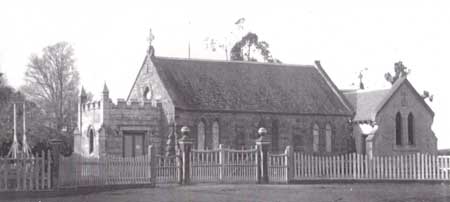
|
Wycliffe Church of England is a substantial structure of old English design, built of rough hewn granite quarried from the hills surrounding the township.
It was erected under the supervision of Mr. H. R. Caselli, architect, of Ballarat, who also supervised the erection of the brick vicarage as a residence.
Wycliffe Church was opened for public worship on 18th January, 1861. The church is nearly fitted up and has three fine windows which are much admired, one of which was dedicated in memory of Wilfred Campbell Wilson, Lieutenant Northumberland Company Imperial Yeomanry, second son of Sir Samuel Wilson, Kt., of Ercildourne, who succumbed to wounds received in the Transvaal.
Another window was placed in the church by brothers and sisters in memory of Charles Vaughan, Sergeant Australian Imperial Regiment, who was killed in action in the Transvaal on 18th Febuary, 1901. There is also a window in the east end subscribed for by the church people.The vestry was added to the church at a later date in memory of Thomas Bath, J.P., and his wife, who were pioneer members and founders of the church.A porch was added also, and several tablets have been placed in the church from time to time in memory of its early members. There is a large Honour Boardin memory of those who fought in the Great War. A Parish Hall (pictured below) was erected near the church and opened in September, 1906.
|
|
Regular services have been held since the opening of the church in 1861 down to the present time. Among the visitors of distinction from overseas who have attended Divine service in Wycliffe Church was His Royal Highness The Duke of Gloucester in 1934, and His Excellency Lord Huntingfield this year (1937).
The first vicar in charge of Learmonth Parish was the Rev. Postlethwaite, who left in 1859. The vicars who succeeded him and the dates are as follows:-
Reverend - H. N. Wollaston in 1860. W. T. Sargeant in 1863. E. S. Radcliff in 1866. C. H. Rupp in 1873. M. F. Cahill in 1876. S. Walker in 1877. W. Swinburn in 1892. C. H. L. Rupp in 1898. T. P. Bennett in 1905. F. L. Sugget in 1909. W. E. Kaneen in 1912. E. J. Dodd in 1915. A. B. Rowell in 1922. F. F. Fell in 1924. (now in charge)
Updated for "Back To Learmonth And District" 25th to 28th January 1957.
|
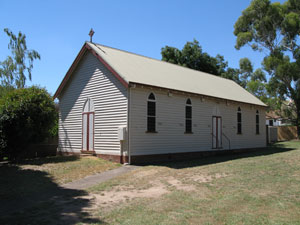
|
|
|
Parish vacant in March, 1942, following the retirement of Rev. F. F. Fell.
With the Rev. W. J. Tame's appointment in July, 1942, the parishes of Learmonth and Beaufort amalgamated and have since remained as combined parishes under the care of a minister from Beaufort.
Rev. W. J. Tame was inducted in 1942. Rev. G. A. Bunne, 1947. Rev. Bull, 1949. Rev. A. L. Mills, our present vicar, 1950.
The following renovations and additions have been made since the last "Back to Learmonth":- Electricity installed in memory of Mr. W. Tinkler, who died in 1941.
Dedication of new Pulpit, in memory of Mr. Charles Dean, who died in 1943, and a new Alter given by Miss Alice Ford in memory of her mother and sister. Erection of front fence and gates, 1949.
Complete renovation to church made possible in 1952 by a gift from the estate of the late W. A. Gilmore. In July of the same year our Church was consecrated and re-named All Saints, by the Bishop of Ballarat.
This year, electric power points and heaters have been provided in the Church and Sunday School.
|
|
Office- Bearers are:
Committee: Messrs. E. S. Bridgewater, N. Wettenhall, M. Dean R. Walker, A. Dean, F. Lawrence, K. Loader, A. McKay, J. Cairns, T. Flavell, L. Loader, N. E. Whittenbury (Secretary and Treasurer).
Central committee: E. S. Bridgewater and N. E. Whittenbury (wardens), M. Wettenhall (vicar's warden and secretary).
Sunday School (10am): Teachers: N. Whittenbury (Superintendent), M. Wettenhall, M. Lawrence.
Companionship Club (7.30, Friday) - Leaders: Misses N. and J. Whittenbury.
Tennis Club: A. Mckay (captain), B. Dean (vice-captain), K. Loader (secretary).
Ladies' Guild: Mrs. A. L. Mills (President), Mesdames A. Dean and Crockford (Vic-President), Mrs. N. Wettenhall (Secretary).
Church Organist: Mrs. L. Rasdell.
|
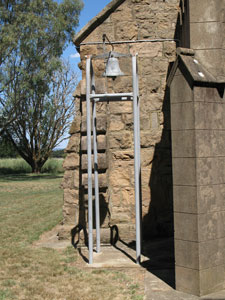
|
|
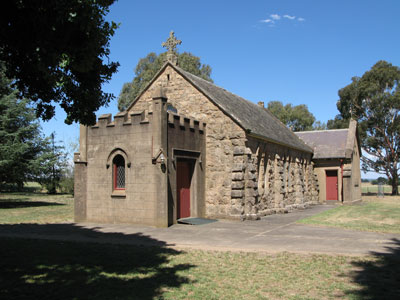
|
The following article was researched and written by Mrs Claudette Crick.
On September 12th 1859 the committe of the Presbyterian Church, through Rev. Mackie, recieved a request from the Episcopalian denomination to hold services in their Church. It was resolved to "grant the request of that body, by allowing the adherents of the Church of England to hold occasional services in our church". (from the minute book of the Presbyterian Church).
Land originally chosen by Wm. Vaughan, which was later forfeited, and an adjoining block purchased by Day, Brydon & Hedrick at the Learmonth land sales of 1859 was the land chosen by the members of the Church of England to build their church. In the "Ballarat Star", the Learmonth Correspondent wrote "The Church lately erected here by the members of the Church of England was opened on Sunday last, 20th Jan 1861 when an excellent sermon was preached by Rev Mr. Woolaston recently appointed minister of Miners Rest and Learmonth. About 90 persons attended the church, several from a considerable distance. Caselli was the architect, and it is neatly fitted up. The parsonage is to be commenced at once in the adjoining church reserve". The church was known as Wycliffe Church. This would have been a wooden church and the parsonage was to be built of brick.
|
|
Two of the marriages that took place in this church in 1865 were —February 28th the marriage of Annie, nice of Thomas Bath. August 3rd Edmund Beseler married Emma Flower, nice of Robert Pool of "Flower Pool Cottage".
The Learmonth Private Glee and Madrigal Union made its first public appearance at the Shire Hall on Dec 3rd 1867. Proceeds of the evening were given to the trustees of the Wycliffe Church towards funds being raised for the purchase of a new harmonica.
A correspondent report of May14 1868 states — a soiree held at the Temperance Hall for the Church of England raised funds on behalf of the Minister of their church. The debt of £200 ($400) on the church, parsonage and ground, had been liquidated, and now they have a church, it was their duty to have a minister as well. The Rechabites for the use of the hall, ladies providing tea, speakers, singers and Chairman were thanked in helping to make a successful evening.
In 1883 a Mrs McPherson (staying at Labona ) who was baptised and married in the church, presented a new organ, an instrument which possessed 11? stops and had "considerable power and sweetness" — it was imported by Allans.
|
|
Return to sites list
|
|
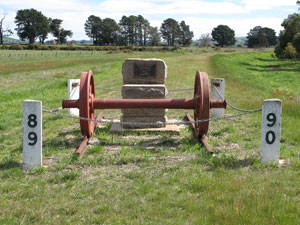
|
18: Railway Centenary Monument
The monument was erected in 1988 (Australian Bi-Centenial year) by the Learmonth & District Historical Society to mark 100 years of the Racecourse to The Springs (Waubra) railway.
|
|
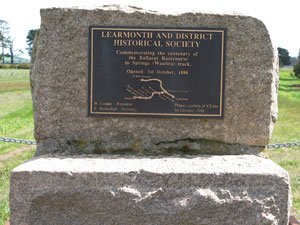
|
The following article on the history of the railway was researched and written by Mrs. Claudette Crick.
The Racecourse to The Springs (later Waubra) Line began as a spur line off the Ballarat – Maryborough line to service the Dowling Forest Racecourse. Opened on 14th April 1881, the special train from Melbourne arrived just prior to the first race. The official party attended a luncheon provided by the stewards of the club. It is interesting to note how a railway line could be built to cater for about 6 trips a year for about 10,000 fares over the year.
The farmers of the rich agricultural district NW of Ballarat had long agitated for a railway to deliver their goods to Ballarat, and many hours of meetings were spent at district gatherings planning their preferred routes.
The Springs Railway had been mentioned in the Railway Annual Report of 1883, where it was reported that a trial survey of a line between the Ballarat Racecourse and The Springs had been completed. It wasn't until the famous Octopus Act of 1884 that construction for such lines was authorised.
|
|
Tenders for the branch line to The Springs were called in 1887. The name was changed to Waubra with the advent of the railway, as there was another settlement of that name in Victoria. The contractors for the line were Welch and Yeoman, the contract amount being £27,750 ($55,500.00) for the 13 miles and 60 chain of railway.
The contract stipulated that the works should be completed by March 5th 1888, however the official opening was not held until much later. 125 men were employed to build the line, 100 of whom were engaged in the earthworks with 38 horses, 32 drays and 2 ploughs. Construction was over fairly flat country, which provided few problems.
Other contracts let during the construction period and the first two years of operation included a signal box at the Ballarat Racecourse Junction and a turntable at Waubra, where a windmill and water supply works were also erected. Six gatekeepers cottages were built at a total cost of £1142 ($2284). A goods shed and a hay platform indicating a chaff mill, was the first of five such mills built to use the railway facilities.
The official opening of the line took place on October Ist, 1888. A large number of guests including the Commissioner for Railways, Commissioner for Customs and Parliamentary representatives were conveyed to The Springs by a special train which left Ballarat at 11.45 am and returned at 5.00 pm. Guest, entertained at the terminus by Prout's Brass Band, were welcomed by the Presidents of Ballarat and Lexton Shires and entertained to a banquet in a marque erected near the station.
|
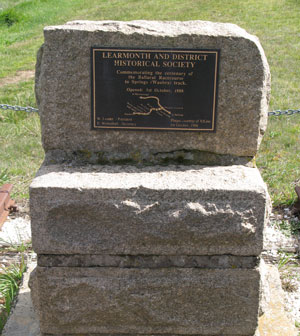
|
|
The original station names along the line were – Midas, Miners Rest, Learmonth, Addington and The Springs when two mixed trains a day each way were provided. The station names were soon changed to Waubra Junction, Pisgah, Midas, Blowhard, Learmonth, Learmonth North and Waubra. The Learmonth North station was later used for goods traffic consigned to R Crossthwaite at the Post Office Store. Cobb & Co advertised that from October Ist 1888 - a coach would run from the Stag Hotel to the Railway Station to meet each train, Fares 6 pence each way. This price was quickly reduced.
The line was never very financial; expenses being greater than anticipated, by 1896 eight gatehouses had been abolished. In 1897 the train originated from Waubra where it remained overnight. Residences were provided for an engine driver, fireman and travelling stationmaster.
By 1931 passenger services were discontinued, and by 1940 partly due to coal shortages and wartime restrictions the goods service only ran one day per week.
The Waubra Line was a favourite of the railway employees. Once they had left Waubra Junction they had no gate houses or signals to look out for and a game of cards whilst eating their lunch sitting on the Waubra platform was a leisurely affair. There was more than one occasion that the Staff was left on the platform, not noticed until they reached the Learmonth station on the return journey.
|
While not a financial proposition for the railways, the carriage of a large amount of stock and agricultural goods from the surrounding areas was very beneficial for the district.
The 1st Octoctober 1988 was a very cold and windy day, but this didn't dampen the enthusiasm of those in attendance. Former railway employees and their families were amongst those who came to witness the unveiling of the commemorative monument by the Shire President Cr. Reg Kinnersly and to listen to a very interesting talk on the history of the line from Adrian Ponton, a member of the Australian Railway Historical Society.
Special guests were Mr Murray and Mrs Stevens whose father was Station Master of the Waubra Junction Station during the early 1900s.
A Centenary lunch was held at the Mechanics Institute followed by an excellent display of railway memorabilia, which included many photos of the stations, given to the society by the Australian Railway Historical Society.
For more details on the Racecourse to The Springs Railway purchase a copy of the society's "Waubra - A history of a Branch Line"
|
| |
Return to sites list |
19: Medwell's Chaff Mill
|
|
|
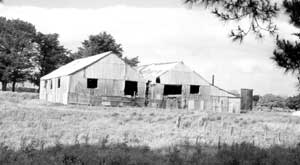
|
Medwell's Chaffmill was built by Richard Medwell in 1909 for the cutting of oaten hay into chaff. The mill was built near the railway line, the chaff was loaded into railway trucks and taken to the Melbourne market for sale. Up until then the hay was cut by a chaff cutter travelling from farm to farm, it was pulled and driven by a steam engine.
Following the railways closure in 1968 the chaff was carted by road to the Melbourne market.
The mill continued to be operated by the Medwell family for many years, after the death of Hector Medwell in 1973, the business was sold to K and B Tyner who continues the cutting of chaff on the site.
Tyner later closed the mill, which was dismantled, and transfered the chaff cutting business to their Newlyn site.
|
| Return to sites list |
Researched and written by Mrs Claudette Crick. |
21: Lowes Bakery
|
|
| More detail coming soon. |
From "The Ballarat Star" November 12, 1873.
THIS DAY
At Two o'clock,
At the Stag Hotel, Lake Learmonth.
______________________
ABSOLUTE SALE BY AUCTION
of
BAKERY AND GENERAL STORE,
Situate High Street, in the Township of Learmonth;
With the Goodwill of the Business.
______________________
By order of Mr THOMAS LOWE, in consequence of his going
into Farming Pursuits.
______________________
R. TUNBRIDGE and CO., under instructions from T. Lowe Esc, will
SELL by PUBLIC AUCTION, on Wednesday, 12th November, at Two o'clock,
at the Stag Hotel, Lake Learmonh, immediately after the sale of
Mr Rob't Stewart's Farm.
2 acres of LAND in the township of Learmonth, having three handsome frontages,
upon which is erected Store and Bakery, containing shop 22 x 16, with fixtures
complete, storeroom built of brick, 21 x 13: 1 brick built bakehouse - oven for wood,
1 wooden bakehouse with furnace oven, dining-room, mens-room, 2 bed-rooms, - the
whole verandered in ?????; also, 4-stalled stable with loft, 2 cart horses, one chaff
and harness-room, pisseries &c.
About a quarter of an acre of the land is laid out as a fruit and vegetable garden,
a paddock with lucerne; and there is also a splendid supply of water all year round.
N.B. -To parties in search of an opening to go into business this sale affords a
splendidoppertunity, as Mr Lowe has been baking at the rate of two tons of flour
per week, and also doing a very good trade in groceries and general goods.
|
| |
Return to sites list |
| |
23: Reid Bros. Chaff Mill
|
|
Reid Bros., Produce Merchants of Northcote developed their chaff mill, measuring 60 feet x 30 feet, in Learmonth in 1888 when the railway route to The Springs (now Waubra) was confirmed. They had a ready market, and goods could be carried directly to the ships. This mill served the farmers of the Learmonth district by cutting their crops into chaff at the mill. Prior to this the crops were cut by a travelling, steam driven, chaff cutter which went from farm to farm.
Tenders were called for on the 9th of June 1890 for the erection of a hay dock at the Learmonth Station. In August of 1900 a petition of ratepayers requested the Shire Council to move the weighbridge from its present site to another site on the main road opposite the chaff mill.
Reid Bros. wrote to the council in may of 1900 stating that they intended to raise the road level on the west side of their chaff mill, and asked the council for "a few loads of metal to raise the footpath and roadway to correspond".
On New Years Eve 1900, the steam whistle at the mill was blown at midnight to celebrate the beginning of "Federation".
Reid Bros. also had a private railway siding which was opened in 1902, located about half a mile from the station. In 1915 the siding was renamed Wards Siding and was closed in 1920.
The mill was sold to Harold S K Ward Pty Ltd of 24 - 28 Spencer St. Melbourne, they continued to cut chaff until 1919 when the mill, "being in need of repairs ceased to function". Medwell's mill of Learmonth then cut chaff for H S K Ward Pty Ltd. The old Reid's Mill was used for storage in conjuction with the Medwell mill was dismantled in the 1930s.
H S K Ward had other mills around the Melton, Rockbank and Sydenham areas. All their mills were built beside railway lines, the fate of many former chaff mills was to be destroyed by fire. The last remaining structure of many of these mills is the weighbridge.
|
|
| |
Return to sites list |
|
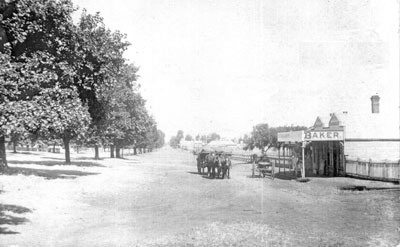
Barnes' Bakery c1900
|
24: Barnes, Grocer/Baker/Undertaker
|
|
This is another of the oldest buildings in Learmonth, built in 1861. Thomas Barnes, a builder by trade, soon saw the need for a store. He ran a grocery store, sold hardware, produce and ran a bakery and timber yard.
Barnes made the coffins for some of the early burials and later became Learmonth's undertaker, the business still operates in Ballarat today under the name of F W Barnes & Sons.
The Ryan family operated a business in this building from about 1930 until 2005 when it was closed.
The old store has resently been completely renovated and now operates 7 days a week as Cafe 321.
More detail coming soon.
|
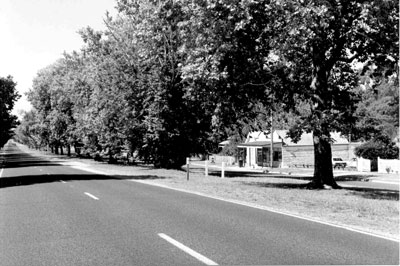
Barnes' shop in 2005
|
| |
Return to sites list |
25: Temperance Hall
|
|
| Town legend has it that His Royal Highness the Duke of Edinburgh opened the Temperance Hall, to date the LDHS has failed to find confirmation of this, just that he was in Learmonth on the December 11th 1867. |
In May 1866 the Independent Order of Rechabites discussed erecting a hall in Learmonth as, they believed, one was needed for both Lodge and public use, such as meetings, reading rooms and a public library. They hoped a suitable site could be found as Learmonth was growing rapidly.
As the Duke of Edinburgh was coming to Ballarat during his Royal Tour to Australia it was hoped he would visit Learmonth. This visit did in fact take place on December 11th 1867. A Royal Regatta was held on Lake Learmonth in his honour.
The committee "set to work in good earnest" to complete a structure in time for the Royal Visit and to hold a Soiree that evening.
It wasn't until November 18th 1867 that a site was reserved for the purpose of constructing a "Temperance Hall". A bazaar, private subscription and the publication of the now treasured "Learmonth Thunderer" (newspaper) helped raise £100 ($200) in less than a week to help towards the costs of the building. the hall was to be 30 feet wide by 60 feet long and covered with a semi-circular corrugated iron roof. It is believed that George Dean would have been the builder.
The "Ballarat Star" reported on the Rechabite Soiree at Learmonth - "provision was made for something like a thousand people, but owing to the very disagreeable weather during the later part of the afternoon which took many home earlier from the regatta and other sports than if otherwise, only about 400 sat down to tea. After the tables were cleared and seats furnished, evening entertainment and speeches began."
On April 13th 1868, tenders were called for "10 backed seats, 20 forms, a platform 30 feet x 8 feet and lining the interior of the new Temperance Hall with soft wood".
1870 saw the hall recieve 3 coats of paint "not before it was wanted " according to the locals. A question arose in the town when an itinerant hawker wanted to use the hall, as funds were still required towards hall costs and local would be called upon to help, it was though that the outside would be selling goods to the detriment of the storkeepers. "The hall was built for special purposes not to be turned into a Paddy's Market".
The revenue of the hall grew considerably while the government rented the hall for three and a half years from 1873, at the rental of £1 ($2) per week, for use as a State School. This additional income helped to pay for the rights of the land, cleaning and lighting.
The Defence Department, through Dr. Courtney in 1909, applied to use a room as a storeroom and office for th Light Horse. Two other rooms were rented later. The lease wasn't terminated iuntil October 1922.
On November 13th 1912 the Temperance Hall site was revoked and it was duly constituted as the "Learmonth Mechanics' Institute and Free Library. Additions had been made to the hall in 1885 and in 1914 further additions consisting of a new Library and Billiard-room were made at a cost of £300 ($600).
Mr. Rain (well known in the district as he also served as clerk of courts for 60 years) stepped down from the position of secretary, a role he had filled for 57 years, in 1925.
The Temperance Hall / Mechanics' Institute had been use by many groups to raise funds for their organizations and was a valuable means of bringing together people who might otherwise have remained strangers, much good resulted from the meeting, entertainment etc.
Researched by LDHS member Mrs. Claudette Crick.
|
| |
Return to sites list |
26: Court House
|
|
|
Located on th Sunraysia Highway, Learmonth. Built: 1864.
Architect: A. T Snow. Cost: £1,169.
THIS court house was built in 1864 to a design similar to Daylesford's. Five years later local resident William Rain took over as clerk and held the job for the next sixty years. As in most summary courts, the most common charges at Learmonth were for street offences and drunkenness. Irish labourer John Magee was given fourteen days for "soliciting alms in a public place". William Regan, a hawker, was fined five shillings for being drunk in charge of a horse and cart and resisting police. Another hawker, Badoa Singh, was fined the same just for being drunk and using bad language—but he was a 'pagan' Indian.
Six-year-old reformatory boy Samuel Hurly didn't even make it into court. The police arrested him for absconding from his hired service with Mrs Hennessy, and the Reformatory Department simply directed them to hand him over to a Mrs Reece of Waubra.
In December 1893, Theresa Collins, an Irishwoman, "being a common prostitute, did importune a person passing in a public street at Learmonth". It was an unusual charge for such a small township, though nearby Ballarat was said to have fifty hotels that were "mere brothels". Theresa was convicted and fined five shillings.
In 1912 John Donohue, aged eighteen, sauntered into the Camp Hotel Learmonth with a cheque for £25. The publican cashed it and gave the lad three £5 notes and ten gold sovereigns. The elated Donohue shouted drinks for everyone at the bar then wangled himself a lift to Ballarat with a passing brewer's wagon.
Before long the cheque was found to be a forgery and the Ballarat police were notified. They removed Donohue from a Melbourne-bound train, with most of the money still on him—and arranged a refund of 7s 6d on his ticket. Donohue was a simple stable-boy of previous good character. He entered a plea of guilty at Learmonth and was sent to Ballarat for sentence. There, Mr Justice Hood asked if any benevolent body could find the youth some work, then bound him over to behave himself.
Learmonth Court was closed in 1931 and the court house stood empty until 1948 when it was put up for auction with a reserve of £480. The council's request that it be converted into a post office was ignored and the building was sold. It is now a private home.
|
|
Reproduced from "Historic Court Houses Of Victoria"
by Michael Challinger. Palisade Press 2001.
|
|
As the population of Learmonth increased so too did Police business, which was particularly busy at harvest time. On October 5th, 1860, Mr James Service, representing the residents of Learmonth, communicated with the Attorney General, the Honorable J D Wood MP concerning the advisability of establishing a Court of Petty Sessions at that centre. The application was promptly approved, as a letter from the Lake Learmonth Police Station on 16th Nov 1860 indicated that Sen. Con. McGann, the Creswick Police Magistrate, had assumed duties at the court of Petty Sessions.
The newly built Road Board Office was offered for the use of the Court, thus saving the Government some expense. The Bench was composed of the following Justices of the Peace: - Messers George Morton, James McIntosh and Angus Gilchrist, with Sen.Con. McGann visiting from Creswick once a fortnight. On June 14th, 1861 Sen. Con. J H Mather commenced duty as Clerk of Petty Sessions acting). Sen.Con. McGann resigned.
In 1863 it was decided that the Road Board building was not large enough for existing requirements and the Attorney General requested the Public Works Department to proceed with the building of a new courthouse. The successful tenderer was William McKay who had also been the contractor for the Police Complex.
The first court in the new building was held on June 15th 1864. The Learmonth correspondent reported in August - " The court house has been finished in a style that would bear favourable comparison with any similar building in the colony. Fitted with all the requisites of a Court of justice, it is both roomy and comfortable, and a great acquisition to the town. The cost of the building had been about £1200 ($2400), and the large plot of ground on which it is erected in front of the lake, is being planted with trees and shrubs to improve its appearance still further. The necessary police offices are situated at a convenient distance off, and are built in a similar style; the whole forming a cluster of buildings such as for size and finish is rarely to be met with in our country towns."
In 1869, Mr William Rain, a local resident was asked to hold the office of the Clerk of Petty Sessions, releasing the Police of the duty. He held the position until 1929, spanning a period of 60 years. Following his resignation, the Creswick Clerk of Petty Sessions visited the court twice a month.
By 1931 the volume of business handled at Learmonth had decreased so noticeably than the Attorney General directed the court to be close as from Nov 30th 1931.
|
| Researched and written by Mrs Claudette Crick. |
Return to sites list |
| 27: Police Complex |
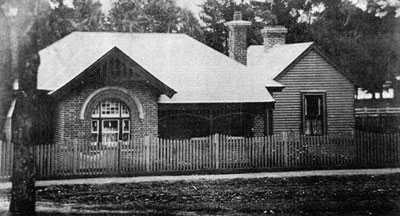
Learmonth Police Station & Residence - 1907
|
|
The orginal Police Station was opened on 30th October 1859.
The current buildings on this site were built in 1863.
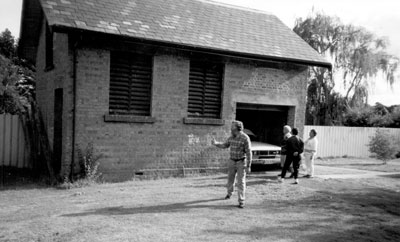
|
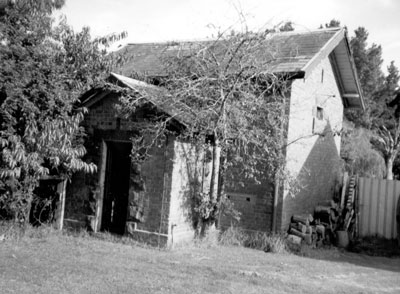
|
|
Learmonth Police Stables - 1992
|
Learmonth Police Cell - 1992
|
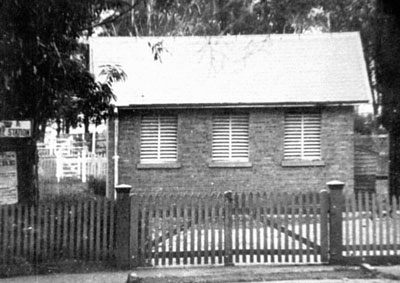 |
The first police presence in Learmonth was October 30th, 1859, when the police used one of William McKay's houses near the Stag Hotel as their barracks. The first constables were Hart and McMannus.The first arrest was notmade until November 21st 1860 by Con. McMannus.
The Learmonth Police District was proclaimed in August 1861. The principal objects in view in recommending such a proclamation were:
1st, the protection of a pathway recently formed by the inhabitants of Learmonth through the township,
2nd, the protection of the waters of Lake Learmonth from pollution.
Tenders were called for the erection of a Police Complex, with the work to be under the supervision of William McKay. The first lockup built on the gazetted site was "a unique structure of exploded corrugated iron" a sentry box, 8ft 6 ins x 9ft.After examiningsame, it seemed a surprise that some of the desparate characters occasionally incarcerated at night were found there in the morning.(It is believed that this "lock-up" stood on the McKay site).
The brick watchhouse was completed in 1863, with stables and barracks built at the same time.
From October 1888, the railway carried supplies for the police horses. The storage capacity at Learmonth was 15 centals for oats, 2 centals for bran, 20 centals for hay and 8 centals for dtraw. 1 cental = 100 pounds or about 45 kgs.
Return to sites list
|
28: Masonic Lodge Hall.
|
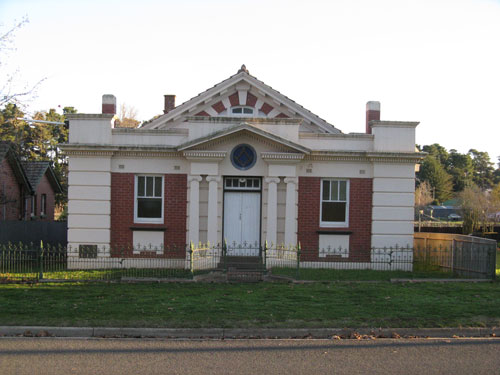
|
Learmonth Masonic Lodge.
Researched and written by LDHS member, Mrs Claudette Crick.
The Learmonth Masonic Lodge, with sponsorship from the Yarrowee Lodge was formed at a meeting on December 7th 1894, with Bro. John Baird being inducted as the first Wor. Master. Meetings were held at the Shire Hall at an initial rent of £3 ($6) per annum until the present building was established.
In its fledgling days the Lodge frequently had difficulty in getting sufficient members present to fill the offices. Alterations to the railway timetables enabled visitors from Ballarat to arrive by train in time for the meeting and return by the later train. This was a great help to maintain membership and also for local members who had moved into Ballarat to attend meetings. Members were summoned to meet at 7.30 on the Friday night on or before full moon.
A building fund was established in 1898, and a block of land was purchased. This was later sold when Mr. F Barnes, a lodge member, donated the land on which the building now stands.In 1914 Wor. Bro. McCubbin successfully moved "that the time is now opportune to consider the advisability of erecting a Masonic Temple". Plans and specifications were drawn up and George Dean, a builder from Learmonth won the contract at the cost of £1100 ($2200).A large crowd gathered to watch the laying of the cornerstone by the original Master of the Lodge, John Baird. As the building progressed, the opening date was set for November 12th 1915.W. Anderson of Windermere, a very skilful craftsman donated the wrought iron fence. George Dean added the canopy over the east, which had been in the original plans, in June 1927 for the sum of £109 ($218).The lodge was connected to electricity when power came to Learmonth; the former gas lighting plant was then sold.
|
|
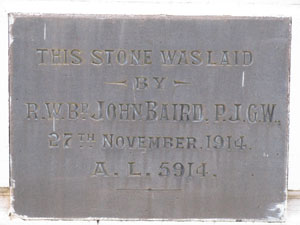
|
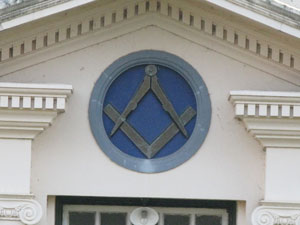
|
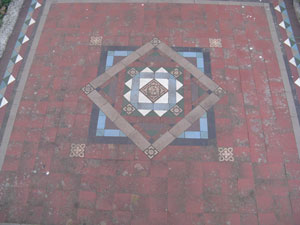
|
|
History of THE MASONIC LODGE, LEARMONTH.
by D. Baird
Reproduce from "Back to Learmonth" Centenary Celebrations 1937. -
The Learmonth Masonic Lodge was founded in the year 1894, The Yarrowee Lodge No 10 being its sponsor. The foundation members were Bros. John Baird, John McKerrow, Robert John Dobson, John Fisher, Henry Thomas Hughes, Duncan Stewart and John Trewin.The first meeting was held in the Shire Hall. Leamonth, on December 7th, 1894. The chair was occupied by Rt. Wor. Bro. Geo. Baker, D.G.M., supported by Most Wor. Bro. the Hon. Sir W. J. Clarke, K.C.M.G. The Lodge was consecrated by the Grand Lodge Officers present Bro. John Baird was then installed as the first W.M. by Wor. E. Verey, W.M. of Yarrowee Lodge. The following Brethren were the first Officers :--I.P.M., Wor. Bro. Ruffle; S.W., Bro. R.J. Dobson; J.W., Bro. J McKerrow; Treasurer. Bro. J Fisher; Secretary, Bro. H.T. Hughes; Deacons, Bros. D. Stewart and J. Trewin; Tyler, Wor. Bro. E. Wattes.The first to be initiated in this Lodge were Messrs. W. Rain, F. Perkins, G. Kilfoyle, J. Kennedy, A. Blair, J. Thomas, R. Davenport, J. Dickie, F. G. Barrett, C. Edmonston and J. Surman. On the 25th November, 1898, Bro. Rain was installed W. M., being the first initiated in the Lodhe to receive that honour.
The Lodge continued to meet in the Shire Hall until the Present Temple was erected. The land on which it is built was generously donated by Wor. Bro. F. W. Barnes, a P.M. of the Lodge. On the afternoon of Friday, November 27th 1914, the foundation stone was laid. Wor. Bro. P. Hart presided and presented a silver trowel to Rt. Wor.Bro. John Baird, a foundation member and first Master of the Lodge, and requested him to perfom the ceremony of laying the corner stone.The Temple was erected by Wor. Bro. George Dean, a P.M. of the Lodge and a contractor of this township. On Friday, November 12th, 1915, the Lodge opened for the first time in the new Temple. The chair was occupied by the W.M., Wor. Bro. C. Medwell. The Grand Master, Most Wor. Bro. Carty Salmon, was present. The Installation ceremony was carried out, Wor. Bro. David Brewster being the first to hold the office of Master in the new Temple.
The office-bearers in the Lodge at the present time are:- W.M. Wor. Bro. N.S. Parker; I.P.M.., Wor. Bro. A. McL. Bain, S.W.., Bro. S.R. Goldsmith; J.W.., Bro. E. Edwards; Chaplain, Bro. the Rev. F.F. Fell; Treasurer, Wor. Bro. R.A. Dowler; Secretary, Wor. Bro. D. Baird; Deacons, Bros. R.T. White and J.E. Coutts; D.C., Wor. Bro. J.A.M. Trewin; Organist, Bro. E. Boustead; I.G., Bro. J.G. Coutts; Tyler, Bro. W.J.T. Scott; Stewards, Bros. R. Young, W.D. Newton, K.C. Edmonston, A. C. Crick and L.O. Hucker. These brethren are meeting under much more favorable conditions than was the case in the early history of the Lodge.
*********************************************************************************************************************
Update to above article reproduced from: "Back to" Learmonth and District. 25th to 28th January 1957 Souvenir Programme.
Office-bearers in the Lodge at the present time are:- W.M., Wor. Bro. G. R. Charles; I.P.M., Wor. Bro. L. O. Hucker; S.W., Bro. A. Hinchcliffe; J.W., Bros. W. H. Kopke; Chaplain, Bro N.C. Blackie; Treasurer, Wor. Bro. K. C. Edmonson; Secretary, Wor. Bro. D Baird; D.C., Wor. Bros. D. A. Baird; S.D., Bro. W. A. Walton; J.D., Bro. M. T. Draffin; Choirmaster, Bro. E. Bald; I.G., Bro. M. Gorman; Tyler, Bro. R. A. Newton; Stewards, Bros. J.G. Draffin, F. J. Stephens; W. F. Cox; C. A. Blackmore, J. J. Grills, K. Smith, N. A. Trewin, C. Toogood.
|
| |
Return to sites list
|
|
29: Lugg's Blacksmith
|
|
|
Lugg's Blacksmith shop was one of several that operated in Learmonth.
Founded in the 1860s Lugg was a blacksmith and wheelwright who built and repaired coaches, wagons etc.
|
More detail coming soon.
|
| |
Return to sites list |
|
|
|



